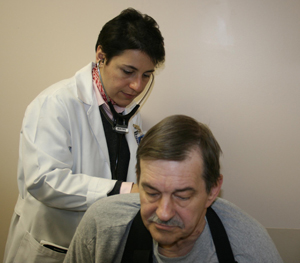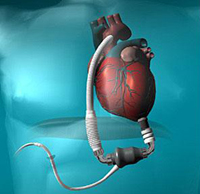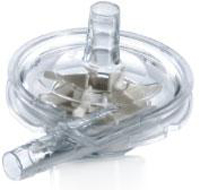 |
Dr. Ioana Dumitru examines Heartmate II patient Dewey Smith during a follow-up appointment. |
“I don’t remember calling 911,” Smith said. “By the time I got to the hospital, my heart had stopped — I had no pulse.”
Staff at another local hospital revived Smith and told him he had a massive heart attack.
“We were on the phone making my funeral arrangements,” Smith said. One of his doctors made a different call — to The Nebraska Medical Center.
“The FDA had just approved the use of the HeartMate II,” said Ioana Dumitru, M.D., assistant professor of cardiology at UNMC and a heart failure specialist at The Nebraska Medical Center. “Dewey seemed to be an excellent candidate for its use. He would have died without it.”
Smith was transferred to The Nebraska Medical Center — UNMC’s hospital partner — for surgery to implant the HeartMate II.
“It’s an open heart surgery,” said Mohammad Quader, M.D., assistant professor of cardiovascular and thoracic surgery at UNMC and cardiothoracic surgeon and director of the heart transplant program at The Nebraska Medical Center. “We connect the device to the left ventricle of the heart. The blood travels from the left ventricle into the pump, and then the pump pushes blood into the aorta.”
The HeartMate II provides several advantages over previous mechanical assist devices.
“It’s more reliable,” said John Um, M.D., assistant professor of cardiovascular and thoracic surgery at UNMC and cardiothoracic surgeon at The Nebraska Medical Center. “It has fewer moving parts than other devices, so it’s less likely to have problems. Fewer parts mean smaller size. That allows us to implant the device in smaller patients; women, even teenagers. These are people who would not have been able to have a mechanical assist device before.”
Other mechanical assist devices use pressurized air to propel the blood around the body. The HeartMate II uses a small turbine, similar to a screw, which spins and moves the blood. The device also requires a constant energy supply. Patients must keep the device plugged into an electrical outlet or a mobile battery pack.
 |
HeartMate II image from Thoratec Corporation. |
 |
CentriMag image from Thoratec Corporation. |
“There are about 2,000 heart transplants every year,” Dr. Um said. “But there are more than 3,000 people on the transplant list at any given time. Our hope is this device will keep more of those people alive long enough to receive a donor heart.”
That is what Dewey Smith hopes for — a third chance at life.
“I was essentially dead when I came to the hospital. This gave me a second chance.”
Another option
Physicians at The Nebraska Medical Center also use another new mechanical option to treat heart failure patients. The CentriMag is a circulatory pump that helps provide quick, temporary help to people who suffer from acute heart failure.
“This device does not require a major open heart surgery,” Dr. Quader said. “It can help restore circulation for patients who need immediate support.”
The CentriMag is used to provide support for a number of hours, or even several days. That time can be critical for a patient whose heart is failing. The device can be placed at the bedside without moving the patient out of bed.
“CentriMag patients stay in the hospital until the device is removed,” Dr. Quader said. “Or until the patient is transplanted, or can be switched to a more long term solution, such as the HeartMate II.”